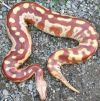
![]()
![]()
Ball python - Python regius
The Ball python is a small species with average adults being around 3-4.5’ Ball pythons predominantly come from a fairly narrow stretch of open forest/grassland type habitats of Western and West Central Africa bordered by the Sahara Desert to the north, the Gulf of Guinea and Congo Rainforest to the South. Ball pythons can be found in many countries throughout its range but most found in the trade came from Ghana, Togo, or Benin. This snake is a short but stocky species. The color and pattern varies quite a bit but typically they have a really dark brown or black base color with random light brown or gold patterned areas made up of splotches, stripes, spots or wide bands. The gold patterned areas can be pattern less but more typically they have several large black spots. Since the early 1990s many dramatic mutations have been found in the wild and were reproduced in captivity. These mutations caused a dramatic increase in interest from keepers of this once maligned species. Now the Ball python is by far the most common species of python kept in captivity.
My collection ~ Currently I focus predominantly on multiple recessive combinations but I also keep many other mutations as well.
Red Blood python - Python brongersmai
Blood pythons average 4-6’ as adults. Red Bloods come from the lower elevations of peninsular Western Malaysia, southwestern Thailand and east of Sumatra’s central dividing mountain range. They also occur on many other islands in the Straits of Malacca and Banka Island. Today most imported Red Bloods come from Sumatra. This species color and pattern varies wildly and just what is normal is hard to discern. Many adult specimens have a deep blood red base color that has given the snake its common name. The head color can be dark gray, silver, red, peach or Black. The patterned elements on the side of the snake are typically splotches or spots and colored in tones of silver and gray with black spots and speckles. The patterned areas along the back are typically made up of broken large thick bands, spots, and or stripes with a yellow-straw color. This is a short tailed and very heavily bodied species. Given the large width of a mature specimen you would think they would be much longer than they are. Many keepers think this is an aggressive species but every young animal I have raised with consistent handling has grown up to be very trustworthy and easy to work with. In recent years many new, exciting, and absolutely stunning morphs have been proven out in this species. The massive variation in color and pattern along with the many new morphs is going to make many keepers take notice of this highly underrated species. If you want a beautiful large snake that is actually not that big you should take a closer look at this species.
My Collection ~ Currently the group I keep of this species is made up of T+, T- albinos and the Batik morph. I hope to add some cool new mutations when they become available.





















